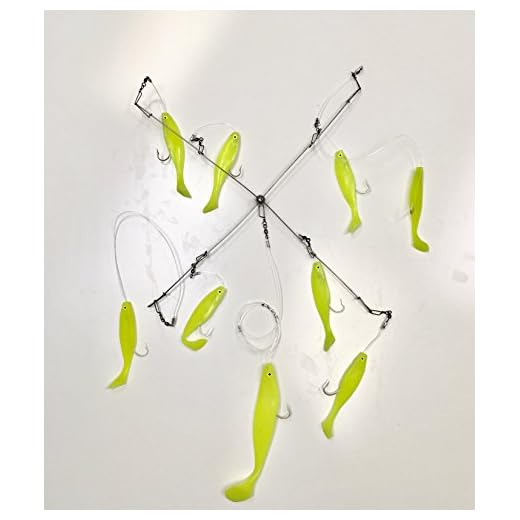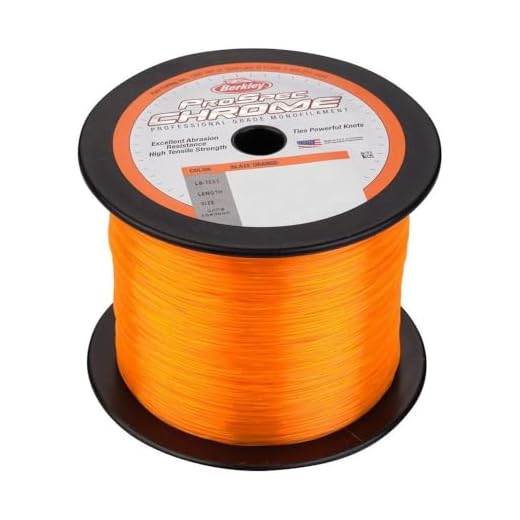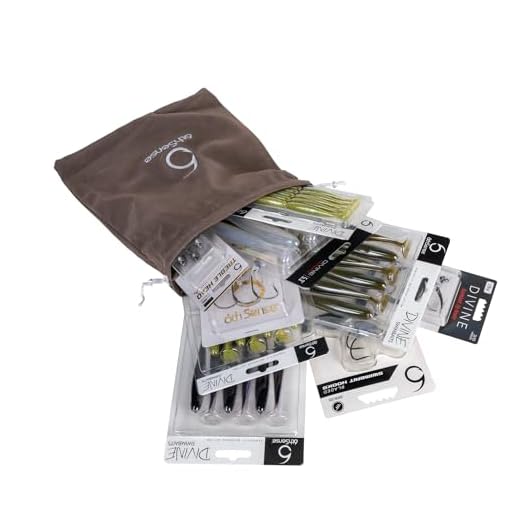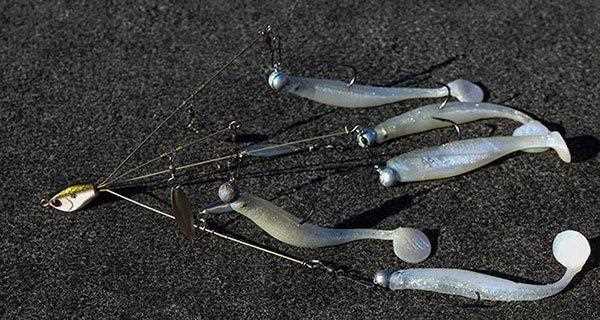




Choosing the right multi-hook configuration can significantly enhance your fishing experience. In this article, I will outline the most effective ways to rig multiple baits, ensuring you maximize your catch rate. Detailed instructions and tips on recommended equipment will be provided, making it easy for both novice and seasoned anglers to implement these techniques.
This guide is designed for anyone looking to improve their fishing strategy, whether you’re targeting bass, pike, or other species. By following the suggestions outlined here, you will learn how to set up multiple baits to attract more fish and increase your chances of success.
Key elements include selecting the appropriate line, understanding the spacing and positioning of your hooks, and choosing the right types of baits. I will also share insights on the best conditions for using this method, ensuring you are well-prepared for your next fishing outing. Get ready to elevate your fishing game with these practical tips!
Best Umbrella Rig Setup
For achieving optimal results with a multi-lure method, consider utilizing a setup that maximizes both maneuverability and bait presentation. A well-balanced combination of line strength and lure selection is paramount for enticing fish effectively.
Begin with a strong braided line, as it offers minimal stretch and enhanced sensitivity. Pair this with a high-quality swivel to reduce line twist, which can hinder performance. Choose a leader line that is slightly more forgiving in terms of stretch, allowing for better hook sets.
Key Components
When selecting lures, opt for a mix that mimics local forage. Ideally, use a combination of smaller swimbaits and spinnerbaits to create a realistic school of baitfish. The following elements are crucial:
- Swimbaits: Select colors that match the prevalent baitfish in the area.
- Spinnerbaits: Incorporate these for added flash and vibration, particularly in murky water conditions.
- Weight: Adjust the weight to suit the depth and current of the fishing spot.
Maintaining the proper retrieval speed is essential; aim for a steady pace that allows the lures to swim naturally. Experiment with slight pauses to mimic the erratic movement of injured prey, which can trigger strikes from predatory species.
Lastly, consider the environmental factors such as water clarity and temperature. Adjust your lure colors and sizes accordingly. Regularly assess your setup for any wear and tear, ensuring all components function seamlessly for an effective fishing experience.
Choosing the Right Umbrella Rig Size
Selecting the appropriate size of your multi-lure system can significantly impact your fishing success. Consider the local fish species and their feeding habits when determining the dimensions. A smaller configuration may work well in shallow waters or when targeting species that are less aggressive, while a larger version can attract bigger fish in deeper or open waters.
The size also influences the presentation of your lures. A compact arrangement allows for a more subtle approach, which is often beneficial in clear water conditions or when fish are wary. Conversely, a more expansive setup can create a more pronounced disturbance, ideal for murkier waters or when trying to provoke a reaction from predatory species.
Factors Influencing Size Selection
- Water Depth: Deeper waters may require larger assemblies to ensure the lures reach the desired depth.
- Species Targeted: Large predatory fish may respond better to bigger configurations that mimic larger schools of baitfish.
- Current Conditions: Strong currents necessitate more weight, influencing the overall size of the system.
- Seasonal Changes: During spawning seasons, a smaller approach can be more effective as fish are less aggressive.
Experimentation is key when determining the best choice for your fishing environment. Adjust the size based on feedback from your fishing experiences, observing what works best under varying conditions. This iterative process will help refine your approach and improve your success rate over time.
Selecting the Optimal Line Type and Strength
For effective fishing with a multiple lure system, selecting the right line type and strength is crucial. Monofilament, fluorocarbon, and braided lines each offer unique advantages that can enhance performance in various conditions.
Monofilament provides excellent stretch, which can be beneficial for absorbing shock during strikes. However, it has higher visibility in water compared to fluorocarbon. Fluorocarbon, being nearly invisible underwater, is suitable for clear water conditions, and its lower stretch can improve sensitivity. Braided line stands out for its high strength-to-diameter ratio, making it ideal for heavy cover and deep water scenarios.
Line Strength Recommendations
Choosing the appropriate line strength is dependent on the size of the fish targeted and the conditions of the fishing environment. Here are some guidelines:
- Light Line (6-10 lb test): Best for smaller species in clear water.
- Medium Line (10-20 lb test): Suitable for a wide range of species and environments, offering a balance between strength and visibility.
- Heavy Line (20+ lb test): Necessary for large fish and heavy cover, providing the durability needed to handle tough battles.
When using a multiple lure system, consider the combined weight of the lures and any additional tackle. Adjust line strength accordingly to prevent breakage when fighting a fish.
Ultimately, matching the line type and strength to the fishing conditions and target species leads to a more successful experience on the water.
Best Lures and Bait Combinations for Umbrella Rigs
For a successful fishing experience with multi-lure setups, selecting the right lures and bait is paramount. Soft plastic swimbaits are a preferred choice due to their versatility and realistic action in the water. Opt for sizes that mimic local forage, particularly shad or minnows, to enhance attraction.
Another effective option is to incorporate hard baits alongside soft plastics. This can create a dynamic presentation that appeals to predatory fish. Jerkbaits or crankbaits can add a different action and sound, increasing the chances of enticing strikes.
Ideal Combinations
- Soft Plastic Swimbaits: Use 3 to 5-inch swimbaits in natural colors, such as white, shad, or chartreuse, to represent baitfish.
- Jerkbaits: Incorporate a suspending jerkbait to create a pause-and-retrieve action, mimicking an injured fish.
- Spinnerbaits: Adding a small spinnerbait can provide flash and vibration, attracting fish from a distance.
Employing a variety of sizes and colors can enhance the effectiveness of your presentation. For instance, using larger lures in the center of the array while placing smaller ones at the ends can create a natural look that fish find irresistible.
Experiment with different retrieval speeds and depths to determine which combination yields the best results. Pay attention to water conditions and fish behavior, adjusting your lures and bait accordingly.
Effective Techniques for Casting and Retrieving
Utilizing a versatile casting technique is essential for maximizing the potential of your multi-lure approach. A sidearm cast allows for a wider spread of the lures, creating a more realistic presentation. Position your body at a 45-degree angle to the water’s surface, ensuring a smooth motion to propel the rig. This technique reduces splash and disturbance, making it easier to entice fish.
For retrieval, maintaining a steady and consistent speed is key. A slow, steady retrieve mimics the natural movement of prey, increasing the likelihood of attracting fish. Experiment with varying retrieval speeds and incorporate occasional pauses to simulate an injured baitfish, which can provoke a predatory response.
Advanced Techniques for Success
- Vary Depth: Adjust your depth by modifying the length of the leader lines. This allows you to target fish at different levels in the water column.
- Use the Wind: Casting with the wind can help you achieve longer distances and better accuracy. Align your casts to take advantage of natural currents.
- Watch for Structure: Target areas with submerged structures, such as rocks or vegetation, where fish are likely to congregate.
Incorporating these techniques can enhance your chances of a successful outing. Pay attention to water conditions and adjust your approach accordingly for optimal results.
Adjusting Your Setup for Different Water Conditions
When fishing in clear water, opt for lighter line and smaller lures to enhance your presentation. This approach creates a more natural look that fish find appealing. A stealthy approach is vital; ensure your movements are minimal to avoid spooking the fish.
In contrast, murky water requires a different strategy. Utilize heavier line and larger, more colorful lures to increase visibility. The vibrations and noise produced by these baits can attract fish from greater distances, compensating for the lack of visibility in the water.
Adapting to Specific Conditions
Consider the following factors when making adjustments:
- Water Clarity: Use transparent or low-visibility line in clear conditions and switch to high-visibility options in stained or muddy water.
- Current Strength: In fast-moving water, heavier weights are necessary to maintain depth and control. Conversely, lighter weights work better in calmer conditions.
- Temperature: During warmer months, fish are often more active; thus, faster retrieves may yield better results. In colder water, slow and deliberate movements can entice bites.
Experiment with different rigging styles based on the environment. For instance, a vertical approach works well in deeper waters, while a horizontal presentation may be more effective in shallower areas. Adjusting the spacing of your lures can also impact success rates; closer spacing can create a more clustered appearance, mimicking a school of baitfish.
In summary, understanding the water conditions is key to optimizing your fishing strategy. Tailoring your equipment and techniques to suit the environment will significantly enhance your chances of a successful outing.
Common Mistakes to Avoid with Umbrella Rigs
Choosing the wrong line weight can significantly impact your success. Heavy lines may hinder the action of the lures, while lighter lines could lead to breakage. Always match your line to the conditions and the weight of the lures you are using.
Another frequent error is using inappropriate lures. Selecting lures that are too large or too small for the rig can diminish its effectiveness. Always opt for lures that complement each other in size and action to create a unified presentation.
Conclusion
Avoiding these common pitfalls will enhance your overall experience. Here are additional mistakes to steer clear of:
- Inefficient retrieval speed: Adjust your speed to find what triggers the fish.
- Poor knot selection: Use reliable knots to ensure connections remain intact during use.
- Ignoring water conditions: Adapt your approach based on clarity, current, and temperature.
- Neglecting maintenance: Regularly check and replace worn components to maintain functionality.
By addressing these issues, anglers can significantly improve their chances of success and enjoy a more fruitful fishing experience.
Best umbrella rig setup
Features
| Part Number | 21100200500E |
| Model | 21100200500E |
| Warranty | Contact Manufacturer |
| Color | Moss Green |
| Release Date | 2017-04-17T00:00:01Z |
| Size | 500YD/20LB |
Features
| Part Number | SFP-SUR |
| Color | White |
Features
| Part Number | PSC1B30-80 |
| Model | PSC1B30-80 |
| Warranty | Manufacturer's Warranty |
| Color | Blaze Orange |
| Release Date | 2021-03-08T00:00:01Z |
| Size | 30lb - 1000yd |
Features
| Color | Various |
| Size | Multiple |
Video:
FAQ:
What is the best rod and reel setup for using an umbrella rig?
When setting up for an umbrella rig, it’s important to choose a rod that is both sturdy and sensitive. A medium-heavy to heavy action rod, around 7 to 8 feet in length, is typically recommended. This length provides the leverage needed to cast the rig effectively and manage the weight of multiple lures. Pair this with a reel that has a high gear ratio, ideally around 6.3:1 or higher, to help retrieve the rig efficiently. A baitcasting reel is often preferred for its precision and control, but a spinning reel can also work well depending on your comfort level.
What types of lures should I use on my umbrella rig?
The choice of lures for your umbrella rig can significantly impact its effectiveness. Swimbaits are a popular option because their action mimics a school of baitfish, which is what the umbrella rig is designed to imitate. Look for swimbaits that are around 3 to 5 inches in length. You can also experiment with different colors and styles to see what works best in your fishing environment. Additionally, some anglers like to add a harder, more buoyant lure in the center position to create a focal point that attracts fish.
How do I determine the best depth to fish with an umbrella rig?
Finding the right depth for fishing with an umbrella rig involves a bit of trial and error, as it depends on various factors like water temperature, time of year, and what species you’re targeting. A good starting point is to begin at the same depth where you have previously found fish. Use a depth finder to locate schools of baitfish or structure where fish might be hiding. Adjust your retrieval speed as well; sometimes a slower retrieve can make all the difference in triggering a bite. Pay attention to any signs of fish activity on the surface or near the bottom, and adjust your depth accordingly.







